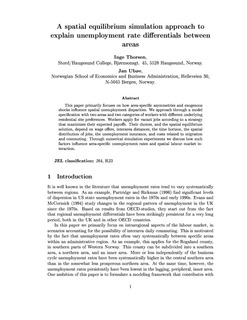| dc.contributor.author | Thorsen, Inge | |
| dc.contributor.author | Ubøe, Jan | |
| dc.date.accessioned | 2006-07-13T10:41:30Z | |
| dc.date.available | 2006-07-13T10:41:30Z | |
| dc.date.issued | 2002 | |
| dc.identifier.issn | 1500-4066 | |
| dc.identifier.uri | http://hdl.handle.net/11250/163703 | |
| dc.description.abstract | This paper primarily focuses on how area-specific asymmetries and exogenous shocks influence spatial unemployment disparities. We approach through a model specification with two areas and two categories of workers with different underlying residential site preferences. Workers apply for vacant jobs according to a strategy that maximizes their expected payoffs. Their choices, and the spatial equilibrium solution, depend on wage offers, interarea distances, the time horizon, the spatial distribution of jobs, the unemployment insurance, and costs related to migration and commuting. Through numerical simulation experiments we discuss how such factors influence area-specific unemployment rates and spatial labour market interaction. | en |
| dc.format.extent | 310602 bytes | |
| dc.format.mimetype | application/pdf | |
| dc.language.iso | eng | en |
| dc.publisher | Norwegian School of Economics and Business Administration. Department of Finance and Management Science | en |
| dc.relation.ispartofseries | Discussion paper | en |
| dc.relation.ispartofseries | 2002:8 | en |
| dc.title | A spatial equilibrium simulation approach to explain unemployment rate differentials between areas | en |
| dc.type | Working paper | en |
